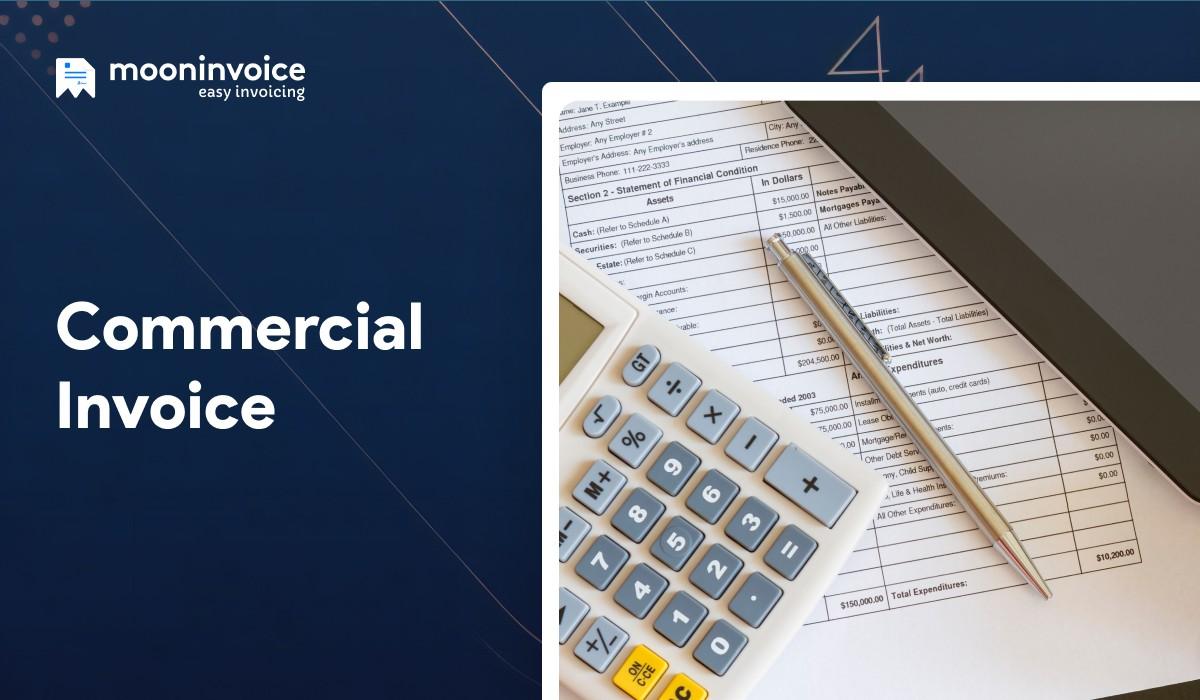International trading is more than just a business, as it connects two nations and fosters a bond between two places separated by international borders. However, this trading is more complicated. It involves the laws, tax rules, and currency exchange of two nations.
A commercial invoice is one of the most crucial documents for international shipping. It is primarily used for customs clearance purposes, assisting customs authorities in calculating and evaluating the duties and taxes that must be paid. Customs uses the breakdown of expenses on this document to determine and assess the import duties and taxes that are owed for the shipment.
In this post, we will outline the meaning of a commercial invoice. Additionally, you will explore why it is necessary. Our guide will share an easy approach to creating it.
📌 Key Takeaways
- A commercial invoice plays a vital role in international shipping.
- The document is very useful to track payments, financial records, and taxation.
- It includes details about the goods being shipped, along with their values and terms of sale.
- Both buyers and sellers can use this document during a dispute, as it serves as a legal document.
- A commercial invoice differs from a standard invoice in terms of its purpose.
What Is a Commercial Invoice?
A commercial invoice is a customs declaration document useful in cross-border trading. It includes details such as the item being shipped, its value, and the transaction between the buyer and seller.
Customs authorities use this invoice to determine the applicable tariffs, taxes, and other duties on imported goods. Thus, it smooths the customs clearance process. This document serves as a legal document & acts as evidence of the financial transaction.
Commercial Invoice Example
We now acquire more clarity with an example of a commercial invoice. Here is a standard format that presents the required details in the commercial invoice. This commercial invoice example contains assumed values.
 Download Commercial Invoice Template
Download Commercial Invoice Template
Here, Azure Technologies, a computer manufacturing & selling firm, issued a commercial invoice to the customer James Smith. The document contains the following details –
Details of Sender & Receiver: The name of the sender, along with the address and contact details. Similarly, it includes the receiver’s name & contact number. The country source and destination countries have also been described here.
Invoice Details: Such as invoice date, invoice number, due date, and PO number. The invoice number is useful to track an invoice.
Product Details: The product types, along with their respective weights, quantities, prices, HS codes, and countries of origin, have been specified. It also contains the types of exports. HSN is a six-digit number code that helps customs officials streamline the taxation process. However, in the USA, it is used as HTS (Harmonized Tariff Schedule), an extended form of HSN, and has 10 digits.
Terms: International commercial terms related to the billing, including highlighting of the due date. The last date is determined in accordance with the agreement between the two parties and aligns with the proforma invoice.
A Hassle-free International Trading is Here
Automate your every commercial invoice & enhance your international trading. Customized invoice templates to create an invoice in just 60 seconds!
Commercial Invoice & Other Customs Documentation: Key Differences
After understanding the definition of a commercial invoice, we can now distinguish it from other documents. This type of invoice and other customs documents are often interchanged and confused by professionals. Here, we find out the key differences between a commercial invoice and other documents:
Commercial Invoice vs CN22/CN23
A commercial invoice is a detailed document used in international trading. CN22 and CN23 are used for customs declarations by postal services.
Here are the other differences:
| Commercial Invoice | CN22 / CN23 |
|---|---|
| A commercial invoice is useful for business transactions and customs purposes. | Useful for the mail shipment. CN22 is suitable for low-value mail shipments, and CN23 is suitable for high-value mail shipments. |
| Business professionals and other exporters use this. | These are useful for small business professionals and individuals. |
| A commercial invoice contains a detailed form. | CN22 contains basic content & value, while CN23 contains detailed customs information and an invoice. |
| It is issued for freight & courier shipping. | It is issued for the postal packages. |
Commercial Invoice vs. Packing List
A commercial invoice majorly focuses on the value and customs clearance, whereas the packing list primarily focuses on shipment details.
Here are the other differences:
| Commercial Invoice | Packing List |
|---|---|
Commercial Invoice vs Custom Invoice
A commercial invoice and a customs invoice are two different documents used in international trade. However, professionals often get confused between these two documents.
Here are the key differences:
| Commercial Invoice | Custom Invoice |
|---|---|
Commercial Invoice vs Shipping Invoice
Commercial invoices and shipping invoices are often confused by professionals. A commercial invoice outlines the details of sold goods and their value. On the other hand, a shipping invoice contains information about shipped items, quantity, and price.
| Commercial Invoice | Shipping Invoice |
|---|---|
| A commercial invoice is a document that outlines the details of the goods being sold, along with their value. | A shipping invoice tells the cost of moving the goods. |
| It is issued by the seller/exporter. | A shipping or freight company issues it. |
| Its focus is on the values of goods. | Its focus is on the cost of transportation. |
| A commercial invoice is useful for banks, customs, and the buyer. | A shipping invoice is useful for the shipper, carrier, and freight forwarder. |
How to Create an Accurate Commercial Invoice for International Shipping?

Creating a commercial invoice is quite similar to creating a standard invoice. However, the difference lies in filling out the details. You can ease the process and ensure accuracy by using a shipping invoice template. When you think over the question of how to create a commercial invoice, follow the steps below:
1. Download a Sample Commercial Invoice Template
To streamline your invoicing process, you should utilize the commercial invoice template. You can find out 66+ customized templates at Moon Invoice. These templates are highly customized and offer a professional outline. Additionally, they commit to accuracy and also boost the invoicing process.
2. Fill out Your Information
Once you have the template, the next step is to fill in the information. You can fill in the data as business name, address, and contact information. Mind it sure to include the complete address, including city, state, zip code & country.
3. Include Invoice Details
Fill in the invoice details, including the invoice number, date, due date, and currency. Keep the invoice number unique for each invoice, as it helps to track them effectively. The invoice date will be the date on which the invoice is created. Moon Invoice automatically assigns invoice numbers every time a new invoice is generated.
4. Fill in Customer Details
You must include the customer’s information, such as their name, address, and contact details. As explained above in step 2, you also need to mention the complete address, including city, state, country, and zip code, here.
The US Dollar dominates international trade. In the World, there are approximately
40% exports invoiced in US Dollars.
5. Fill in the Line Items
Now fill in the line items along with the proper description, quantity, rate & applicable taxes. Additionally, you need to fill out additional information as
- HSN code – Stands for Harmonized System Nomenclature, which is an internationally recognized classification number. It is useful in invoicing, taxation, and customs to smooth the trade.
- Unit Weight – The unit weight is the weight of a single unit product.
- Country of origin – It is also necessary to specify the country of origin on the commercial invoice. This helps to identify the original country where the product was manufactured.
6. Mention Terms and Conditions
Fill in the terms and conditions related to your business. Make your customer well aware of the invoice payment terms. You must also include the shipment terms. Keep the language clean and easy to understand when defining the terms of sale in the commercial invoice.
7. Type of Export and its Reason
In the commercial invoice, it is necessary to mention the type of export and its reason. The type of export is helpful in defining the nature of the shipment. Thus, it is easy for the customs authorities to apply the correct regulations.
Some of the types of exports are as follows:
- Permanent: Goods which are sold and shipped permanently.
- Temporary: These items are shipped for temporary use and must be returned within a specific time period. A notable example is an event where items are shipped for a specified period until the event is completed.
- Repair & Return: Goods that require repair are repaired and then returned to the sender.
8. Authorized Signature
Mention the authorized signature in the section below of the commercial invoice. This helps to present an authorized image of an invoice. With Moon Invoice, you can easily put a customized digital signature.
💡Don’t Forget to Look:
Tips for Creating a Compliant Commercial Invoice
Along with defining the meaning of a commercial invoice and the process of creating it, you must be aware of a few key tips to create an outstanding commercial invoice. Here are the tips you must follow to create an outstanding invoice.
- Use the commercial invoice template to generate a commercial invoice and save time quickly.
- Mention the country of origin.
- Always add weight and packaging information.
- Maintain consistency across all documents.
- Provide complete details of the product, including the product name, part number, material, and HSN code.
- Define all the terms and conditions related to shipping and payment.
- Mention the authorized signature.
- Include the export type.
Common Mistakes to Avoid
There are some common mistakes that one must be aware of and try to avoid:
In complete Information
This is a common mistake that many people make. Professionals fill in incomplete information or wrong information. This leads to a slowdown in the commercial invoicing process.
Incorrect HS Codes
Using the incorrect HS code leads to an incorrect duty and tax assessment. Thus, it delays the customs clearance.
Undervaluing Goods
Some professionals intentionally undervalue the goods. This is a common practice that professionals follow to reduce their duties and taxes. You must declare the correct value of your goods and ensure your business remains compliant with international standards.
Why Choose Our Commercial Invoice Template?
Professionals can easily streamline their commercial billing by using the commercial invoice template. Here are the reasons to use our template to generate an invoice:
Customization: Moon Invoice’s invoice templates are highly customizable. Users can easily customize the template to suit their specific requirements.
Available in multiple formats: Our commercial templates are compatible with MS Word, Excel, Google Docs, Google Sheets & PDF. The user can easily download in any form as per the requirements.
Printable formats: The commercial invoice templates enable users to print invoices easily. Users can easily perform the custom print settings.
Auto-Calculation: Our invoice templates for commercial businesses provide an auto-calculation concept. The template automatically calculates the amount as soon as the user enters the digits.
Last Words
So, what is a commercial invoice for shipping, and how to create it? We presented enough information on the same. A commercial invoice is a vital document for international businesses. Professionals should always handle international shipping with care, as it is a complex and time-consuming process.
Additionally, incorporating invoicing software like Moon Invoice can be helpful in elevating your commercial invoicing. Get into a free sign-up!




















